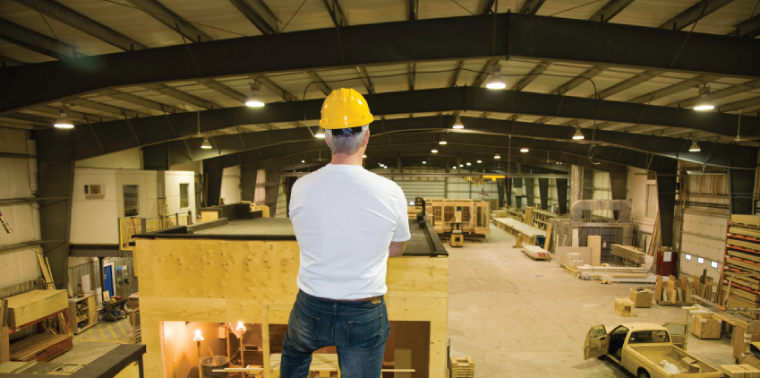April 21, 2014 — When John Quarmley started Highwood USA, a synthetic woods manufacturer, in 2003, he wanted the company to be good to its employees, to its community and especially to the environment.
Based in the small town of Tamaqua, Pa., Highwood uses polystyrene resin and various mineral fillers to make synthetic woods used in everything from patio furniture to gazebos. Quarmley believes the product, essentially a plastic wood, is more eco-friendly than traditional wood because it doesn’t require staining or painting and lasts longer — cutting down on chemical waste and deforestation. Highwood was designed to be environmentally friendly in other ways, too: The waste heat from its machines heats its offices and production floor during the winter, and a closed-loop water system cools its plastics during the production process.
“I’ve joked that we use more water making coffee than we do in our process,” says Quarmley.
But despite being built from the ground up as a green company, Highwood has not remained static. In the decade since it started, the company has found new ways to become even greener — including waste and energy use reduction — by embracing the tenets of lean manufacturing.
Shattered Misconceptions
The concept of lean manufacturing was first developed and perfected after World War II with Toyota’s creation of its revolutionary Toyota Production System as a way to maximize customer value and minimize waste. The automaker shifted its focus on individual production steps to a more holistic view, looking at the product flow through its entire process, making that process more efficient and more adaptable to production needs. Because of this, Toyota was able to converge quality and variety with speed and low costs.
Lean is now considered the gold standard in manufacturing. With lean manufacturing, a company ditches the old method of producing stocks of products based on forecasted customer demands in favor of a more responsive and precise system. The basis of implementation lies in kaizen, a Japanese word meaning the rapid improvement processes that aim to eliminate waste, improve productivity and achieve a state of sustainable continual improvement, according to the Lean Enterprise Institute, a nonprofit education and research organization founded by management expert James Womack, a leader in lean production.
The revelation that “eco-friendly” can be analogous to “profitable” is shattering prior misconceptions that going green comes with a price tag.
Facing the pressures of global competition and rising costs of materials, manufacturers around the world have been adopting lean manufacturing. By identifying opportunities to operate in a more efficient, cost-cutting fashion, they’re saving big money.
At the same time, they’re finding themselves cutting down on raw material consumption, energy usage, and environmental waste and pollution. And the revelation that “eco-friendly” can be analogous to “profitable” is shattering prior misconceptions that going green comes with a price tag.
“When you look at it globally, [lean manufacturing] can position our companies to really be globally competitive,” says Brian Lagas, program manager for continuous improvement at U.S. Department of Commerce’s National Institute of Standards and Technology’s Hollings Manufacturing Extension Partnership, or MEP, which provides training and programs to help manufacturers find ways to be more efficient, and, ultimately, more competitive. “At the bottom line, it’s reducing the environmental impacts while increasing competitive advantage. Reducing energy consumption — that’s just good business,” Lagas says.
Step in the Right Direction
Lean manufacturing is by no means a green “silver bullet.” After all, manufacturing consumes half of all raw materials used over all sectors, while using roughly 30 percent of world’s energy and 20 percent of its water supply. But lean manufacturing can be an important step in the right direction of engraining the green operational mantra of “Reduce, Reuse, Recycle” into manufacturing — and, eventually, moving businesses in the direction of closed-loop, zero-waste processes.
A 2009 survey from Zero Waste Operations Research and Consulting, or ZWORC, showed that manufacturers recognized for successful lean implementation were more apt to effectively integrate an eco-friendly mind-set into their business practices. Many companies were found to have naturally extended objectives of green-focused management, waste reduction and production results — basically, with lean comes green.
But the path to a fully sustainable, zero waste manufacturing operation requires corporate commitment, and time — lots of time.
Getting lean to reach its full green potential will take a while, says Ibrahim Jawahir, director of the Institute for Sustainable Manufacturing at the University of Kentucky. “I think [companies] are moving in the right direction, though,” he says.
Waste Away
With the help of government programs like MEP, lean manufacturing is gaining plenty of traction in the U.S. By 2007, about 70 percent of plants in the country were using lean manufacturing as a mechanism for continuous improvement, according to a survey by the Manufacturing Performance Institute and IndustryWeek, a trade publication. And that number has likely increased as more companies realize the benefits of going lean.
With small staffs and minimal capital, smaller manufacturers like Highwood need resources like those MEP offers. The programs can bring expertise “where some of these small companies just don’t have the eyes and knowledge and really dig deep into these opportunities for waste that they see or even figuring out how to turn waste into profit,” Lagas says.
“We’re not being completely altruistic about it. There’s got to be financial return on the investment.” – John Quarmley
Highwood used MEP advice to help initiate a number of lean projects within its 72,000-square-foot facility, reducing waste throughout its operations in a way that not only lowered costs and increased productivity, but also offered significant environmental benefits.
“We’re not being completely altruistic about it. There’s got to be financial return on the investment,” Quarmley says. “It’s a smart investment to make the changes.”
As the ZWORC study suggests, implementing lean practices led Highwood to other environmentally friendly actions. In 2009, for example, Highwood cut its energy consumption for lighting by more than 50 percent just by retrofitting its facility with high-efficiency fluorescent light bulbs. With help from MEP, the company installed solar panels, which now provide about 20 percent of its energy needs. Beyond the environmental wins found in lean and other efficiency measures, the company is able to find points in its process where things like yield or capacity need to be adjusted — ultimately making its operations more productive.
Other manufacturers are finding similar paired economic and environmental benefits with lean. Through lean approaches, the tractor components manufacturer Hy-Capacity Inc. achieved zero landfill status in 90 days while adding more than $100,000 in sales. The world’s largest shopping cart manufacturer, Unarco Industries of Wagoner, Okla., found $15,000 in annual utility savings and a near complete elimination of hazardous materials use.
Leaning into Sustainability
Building off the lean manufacturing ideals of continuous improvement, in 2010 Quarmley declared a company goal to reach zero waste. He soon found himself diving into the company’s dumpsters on a regular basis, essentially doing an autopsy of the company’s waste streams to find “Reuse” and “Recycle” opportunities. By collecting previously wasted materials — from linear low-density packaging to pallet strapping — and finding a market for them, Highwood not only has reduced its landfill waste by 70 percent, but has reduced monthly removal fees by roughly 65 percent and is even making a tidy profit through sales of the former throwaways.
For Highwood, it’s a cultural realignment. “Having people challenge the status quo and developing a culture where people are not only comfortable but eager to challenge it is rare,” Quarmley says.
Jawahir says the next level requires building off the principles of lean and integrating another set of Rs: Recover, Redesign, Remanufacture.
Still, embracing a lean approach as well as the “Reduce, Reuse, Recycle” mentality is not enough to reach a full sustainability milestone in manufacturing.
“In the ecosystem, what we take from it — the materials, the resources, the energy — produces life cycle stages. Then what happens is we dump so much of it out and create waste,” says Jawahir. “What we’re trying to accomplish is the closed loop.”
Jawahir says the next level requires building off the principles of lean and integrating another set of Rs: Recover, Redesign, Remanufacture. Truly sustainable manufacturing recovers end-of-life products, sustainably redesigns the next generation’s products, and remanufactures those products in a zero-impact way.
That’s a huge undertaking for the global manufacturing industry, one that Jawahir says must start on a small scale and grow to a big one. But in the drive to stay afloat, manufacturers that are dedicated to leaning their processes appear to be heading in that direction, and Jawahir believes lean gives companies the opportunity to take manufacturing to the next level. ![]()
Editor’s note: Justin Miller produced this article as a participant in the Ensia Mentor Program. His mentor for the project was Guardian Sustainable Business editor-at-large Marc Gunther.
Ensia shares solutions-focused stories free of charge through our online magazine and partner media. That means audiences around the world have ready access to stories that can — and do — help them shape a better future. If you value our work, please show your support today.
Yes, I'll support Ensia!
